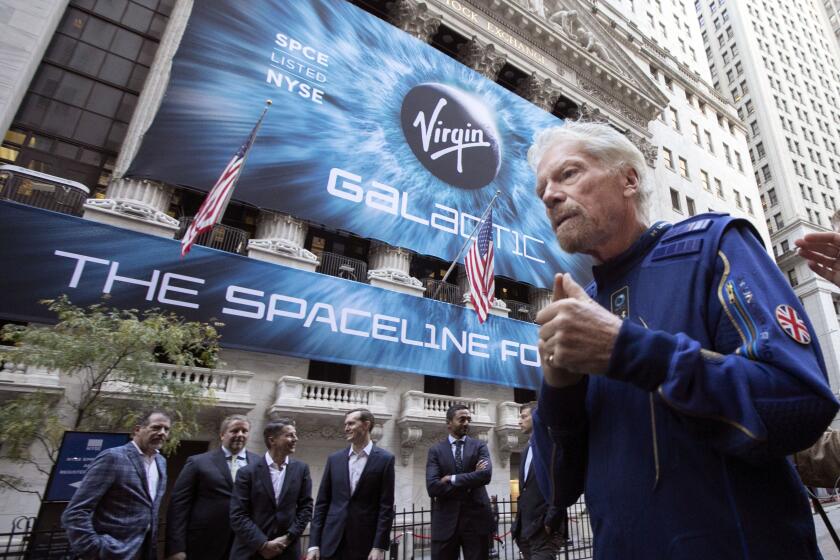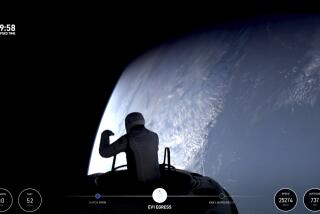Richard Branson and Virgin Galactic crew go to the edge of space and back

In 2004, British billionaire Richard Branson proclaimed he would fly into space on his company’s spaceship in just three years to kick off what he hoped would become a routine travel experience, drinks and all.
Nearly 17 years after that proclamation, he finally did it.
Branson, along with five other Virgin Galactic employees — two pilots and three others who were testing parts of the in-cabin experience, including research opportunities — launched to suborbital space Sunday on the company’s first flight with a full crew aboard. The carrier aircraft with the spaceship attached to its belly took off around 7:40 a.m. Pacific time from a New Mexico spaceport near the city of Truth or Consequences.
The crewed flight marks a shift years in the making, as companies edge into launching recreational trips to space — efforts they hope will eventually prove profitable. The flashy, Branson-flavored Virgin Galactic event — with a livestream hosted by late-night host Stephen Colbert and a concert by singer Khalid — aimed to increase potential customers’ confidence and interest in the flight experience, which costs hundreds of thousands of dollars for a seat.
The spaceship carrying Branson and the others detached from the carrier aircraft about 45 minutes after launch, once it reached an altitude of about 45,000 feet and a designated release point in the airspace. The ship then rocketed to suborbital space.
The craft reached a speed of Mach 3, or 2,300 mph, and a maximum altitude of 53.5 miles above the Earth. The U.S. military and NASA consider space to start at 50 miles above the Earth, though the world body governing aeronautic and astronautic records, as well as other organizations, define space as 62 miles above Earth’s surface, a designation known as the Karman line.
A livestream of the mission showed the crew floating in the cabin once the craft reached space. As the ship returned to Earth, Branson — wearing sunglasses — told viewers on the livestream that it was the “experience of a lifetime.”
The ship landed back at the spaceport around 8:40 a.m. Pacific time, about 15 minutes after it detached from the carrier aircraft. Video inside the cabin showed Branson clapping at touchdown. As he emerged from the spacecraft, he pumped both arms in the air and waved to the assembled crowd.
Branson told reporters after the flight that it was impossible to describe the experience of accelerating to Mach 3 in seven to eight seconds and that the views of the Earth were “breathtaking.”
He added that “99.9% was beyond my wildest dreams.”
“It’s so thrilling when a lifetime’s dream comes true,” said Branson, who carried to space photos of his children, a woman who died but always dreamed of going to space, and a tiny image of the head of Colbert.
The flight put Branson in space ahead of billionaire rival Jeff Bezos, who is due to launch to suborbital space July 20 in a capsule developed by his Blue Origin space company. Bezos congratulated Branson and the Virgin Galactic crew in an Instagram post Sunday, adding, “Can’t wait to join the club!”
An effort to be the first billionaire in space is the biggest vanity project in history.
Like Virgin Galactic, Blue Origin plans to sell tickets to tourists who want to experience a few minutes of weightlessness in suborbital space. Bezos’ company is also developing a larger rocket called New Glenn intended to launch satellites, and it had hoped to win a NASA contract with Lockheed Martin, Draper and Northrop Grumman to build a lunar lander that was instead awarded to Elon Musk’s SpaceX.
Sunday’s flight marks a milestone for the 17-year-old Virgin Galactic, which spent years developing its SpaceShipTwo craft and larger carrier aircraft.
The company has faced its share of setbacks.
In 2014, an earlier version of SpaceShipTwo broke apart in midair during a powered test flight, killing copilot Michael Alsbury and injuring pilot Peter Siebold. The National Transportation Safety Board later concluded that the crash was caused by pilot error and faulted the craft’s builder, Scaled Composites, and the Federal Aviation Administration for failing to create enough safeguards to prevent the accident.
Virgin Galactic brought spaceship construction and development in-house and unveiled a new SpaceShipTwo in 2016. The space plane reached suborbital space for the first time during a 2018 test flight, putting Virgin Galactic closer to its goal of flying tourists who pay for the ride. The company charges as much as $250,000 per ticket and has about 600 people in line.
But after a test flight in 2019, company officials found that a seal had come undone along a stabilizer on the space plane’s wing, which helps keep the plane flying straight, according to a recent book about the company. “Test Gods: Virgin Galactic and the Making of a Modern Astronaut,” by Nicholas Schmidle, quotes Virgin Galactic’s then-vice president for safety and test as saying, “I don’t know how we didn’t lose the vehicle and kill three people.”
A Virgin Galactic official told the Washington Post that although there was damage to the stabilizer, it had no effect on the flying qualities of the space plane and that the company was already implementing an updated stabilizer design for the subsequent spaceship.
Virgin Galactic’s Richard Branson is set to be on a SpaceShipTwo Unity test flight as soon as July 11. Jeff Bezos plans to visit space July 20.
Branson recently told the Associated Press that it was “very important” for potential customers to see him in the spacecraft.
After the flight, Branson also announced a charity sweepstakes for two seats aboard “one of the first” Virgin Galactic spaceflights. The sweepstakes is part of a growing trend of space contests for tourist seats aboard space vehicles — SpaceX is set to launch a private astronaut mission later this year with two contest winners aboard, and Bezos’ flight in July will include an auction winner who bid $28 million for a seat.
Virgin Galactic has said it expects to complete two more test flights before it begins flying customers to space next year.
Mike Moses, company president of space missions and safety, said everything about the flight looked “perfect in real time” and that there were “no issues whatsoever,” other than spotty transmission of audio and video from the spaceship’s cabin to the livestream. The company will do a thorough inspection of the craft and determine the date of the next flight, he said.
More to Read
Inside the business of entertainment
The Wide Shot brings you news, analysis and insights on everything from streaming wars to production — and what it all means for the future.
You may occasionally receive promotional content from the Los Angeles Times.












